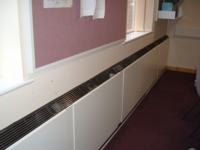Going with the flow

The need to achieve higher efficiencies for heating systems is driving a move towards lower flow and return temperatures in wet systems. David Shuttleworth explores the implications for heat emitters.
During the last few years we have seen some important changes in the design of space-heating systems, with condensing boilers and low- or zero-carbon (LZC) heat sources playing a more significant role. The resultant reduction in flow and return temperatures, combined with improvements to building fabric, means that the heat emitters specified for projects also need to reflect these changes. Unfortunately, some designs still reflect traditional approaches to system design, rather than up-to-date best practice.
For example, the increased use of condensing boilers with a good turndown has led to typical flow/return temperatures of 55/35°C in a wide range of applications, as this arrangement will maximise condensing operation and maximise energy savings. Similarly, many more projects are making use of heat pumps within the system design, necessitating flow/return temperatures of around 50/45°C to improve the coefficient of performance (COP) in cold weather.
For many years, the first choice in these situations was to specify underfloor heating. However, this approach does not take account of the fact that buildings have become much better insulated, so that their steady-state heat loss has reduced while the thermal mass has remained almost constant. The heat emitters, therefore, need to provide rapid warm-up of the space when initially switched on and then be highly responsive to fluctuating internal heat gains and heat losses once the design temperature has been reached — with as little overshoot, or undershoot, as possible.
When viewed in this light, it is clear that underfloor heating does not offer the level of responsiveness that is required, especially in spaces with variable occupancy or which are subject to variable solar heat gains with the changing orientation of the Sun — or both.
In contrast, fan convectors offer a fast response on warm-up and to changing internal temperatures, taking advantage of internal and solar heat gains to reduce energy consumption. In fact, recent tests carried out by an education authority on two similar schools with similar condensing boiler plant suggested that fan convectors using low-grade heat used 30% less energy than underfloor heating to maintain the same design conditions.
Another important point is that fan convectors have been designed to work with a wide range of water temperatures, including the 55/35°C and 50/45°C flow/ return temperatures that optimise the performance of condensing boiler sand heat pumps. They can also be supplied in low-surface-temperature versions (that is, not exceeding 43°C surface temperatures) where this is required by local guidelines or end users’ preferences.
At the same time, it is important to recognise that some specifiers have an aversion to using fan-assisted heating because of the perceived increase in energy consumption to run the fans. While it could be argued that the energy savings achieved by a highly responsive system far outweigh the motor power consumed, this perception cannot be ignored.
In such cases, a responsive and energy-efficient system can be achieved through the use of systems based on natural convection — particularly perimeter, trench or individual natural convectors with low-water-volume heating elements and local controls

Steel panel or aluminium radiators do, of course, offer another alternative, but will often present problems such as high surface temperature and the use of greater wall space when compared with either fan assisted or natural convectors.
A breath of fresh air
An additional consequence of tighter buildings is a greater reliance on mechanical ventilation to meet fresh-air requirements, rather than natural leakage or trickle ventilation. Fan convectors fitted with a fresh-air inlet can provide a versatile solution that will ensure tempered fresh air is introduced to the space at the appropriate volumes, irrespective of weather conditions, respond to changes in occupancy and minimise energy consumption. In effect, the fan convector is used as a small air-handling unit, eliminating the need for the separate air-handling and ventilation systems that are required with underfloor heating or panel radiators.
A similar principle can be applied to perimeter heating, using specially developed vents with motorised dampers and attenuators that can be fitted into the wall of the building, allowing fresh air to be drawn across the high-level heating elements using the ‘stack effect’ or extract fans.
In both case, the fresh-air volumes can be adjusted anywhere between recirculation and 100% fresh air and, where required, linked to carbon-dioxide sensors to provide demand-controlled ventilation.
All of which highlights the need to specify the most appropriate heat emitters for each project, taking account of the local conditions and end-user preferences, as well as the best engineered solution. Our experience across thousands of projects during more than five decades has shown that fan convectors and natural convectors continue to be among the most versatile heat emitters with the inherent flexibility to meet the needs of today’s space heating systems in a highly cost-effective fashion.
David Shuttleworth is technical director with Dunham-Bush.








